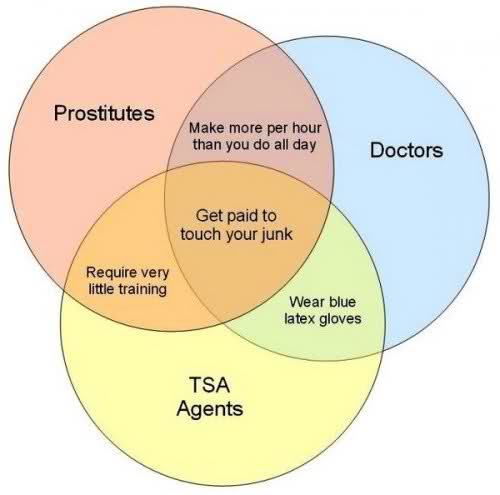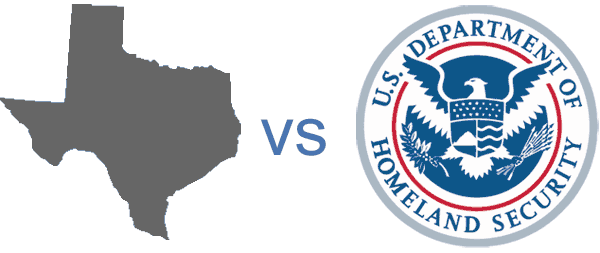TSA vs Doctors vs Prostitutes – What do they have in common? The Ultimate Venn Diagram

Image Courtesy: Imgur.com via Reddit


Image Courtesy: Imgur.com via Reddit
(Source: Houston Chronicle)
I came across this piece by Houston Chronicle’s contributor, Amanda L. Grossman and felt compelled to share with you all. Quite a bit of research has gone into answer this simple question – How much can you buy with $5 inside a plane? Below is a snap shot of Mr. Grossman’s analysis from her blog – Frugal Confessions – A Guide to Thrifty Living.
The chart below is based on flying economy class on a domestic flight (typically including Hawaii and Caribbean). My research shows that most airlines (excluding Southwest) offer an array of expensive and ‘inexpensive’ food offerings (remember you are thousands of feet in the air), and that American Airlines and Continental/United offer more expensive options than others. Wine and cocktails are most expensive on Delta, American Airlines, and Continental, while AirTran even charges for water, milk and premium juices (these are offered as complimentary on other airlines).
| Airline | Cost of Snacks or Meals | Cost of Non-Complimentary Beverages |
| Delta | $2.00-$8.50 | $5.00 Beer, $7.00 wine/cocktails |
| American Airlines | $3.29-$10.00 | $6.00 Beer, $7.00 wine/cocktails |
| Southwest | No food offered for purchase | $3.00 energy drinks, $5.00 beer, liquor and wine |
| Continental/United | $2.99-$9.49 | $6.00-$9.00 |
| AirTran (recently acquired by Southwest) | $1.00-$6.00 | $2.00 water, milk, premium juices, $5.00, $6.00 wine/cocktails |
| jetBlue | $6.00 | $6.00 cocktails |
In order to compare the airline pricing further, I decided to see which airline would give me the most value for my $5 (please note that the products listed below are only offered on certain flights and at certain times of the day). What I found is that I certainly will not get full from any of the airline’s menus if I only want to spend $5. Also, for $5 there are very few healthy snack options (other than nuts, cheese, and dried fruit).
| Airline | Food $5 Will Buy |
| Delta | 1 package of M&Ms ($2.00) or Bentley’s Popcorn ($2.00) and Pringles ($3.00), a Breakfast on the Fly ($3.50 for a granola bar and yogurt for Caribbean and Latin American flights only) or a kids PB&J Plate ($4.50) |
| American Airlines | 1 chocolate chip cookie ($3.29), Lay’s potato crisps ($3.29), a cheese and cracker tray ($4.49), a fruit and nut blend ($4.49), Fisher’s nuts ($4.00) or trail mix ($4.00) |
| Continental/United | 6 oz. can of Blue Diamond almonds $4.99, 2.6 oz. can of Pringles ($2.99), 4 oz. box of strawberry twizzlers ($2.99) or two-bite cinnamon rolls ($2.99) |
| Airtran | “Sky Bites(SM) offers a la carte items, which range from $1 to $4, or combo packages ranging from $4 to $6 in price. A la carte selections include Kraft Foods snacks, such as Oreo Cakesters, Chips Ahoy! cookies, Nilla Wafers, Cheese Nips crackers” (could not find menu and pricing) |
Note: Barring transatlantic-flights, my two top favorite American airlines are Virgin America and Southwest. That said, I hate flying the American carriers during the transatlantic flights. Many European, Middle Eastern and Asian carriers are far better in their service and connectivity than the American carriers, some of them are well known for their appalling service (the worst I have experienced is United, which got me stranded in Dubai for almost 24hrs). What are your favorite domestic & international carriers?
(Source: The Texas Tribune)

Image Courtesy: Theatlanticright.com via Google Images
A threat from the federal government to shut down Texas airports or cancel flights may have killed legislation, House Bill 1937, pushed by Tea Party conservatives in the Texas Capitol to prohibit federal Transportation Security Agents from conducting “invasive searches.”
The Texas Tribune has the scoop: The bill passed by the House earlier this month, would make it a misdemeanor offense for a federal security agent to “intentionally, knowingly, or recklessly [touch] the anus, sexual organ, buttocks, or breast of the other person, including touching through clothing, or touching the other person in a manner that would be offensive to a reasonable person.”
Two TSA officials visited Patrick at the Capitol earlier today to discuss the legislation. They warned him that the legislation “could close down all the airports in Texas,” he said. After their departure, U.S. Attorney John E. Murphy sent a letter to Speaker of the House Joe Straus and Lt. Gov. David Dewhurst saying the bill would “conflict directly with federal law” and that if it became law, “TSA would likely be required to cancel any flight or series of flights for which it could not ensure the safety of passengers and crew” until the agency could seek a court order stopping the measure from being carried out.
Click here to read the rest of the story.
Note: This is not the first time or the first issue the Texas legislature has butted heads with the Federal government. There is the legendary EPA vs Texas reg. the federal takeover of lax pollution standards in the state. And now a new issue looks to threaten the already fractured relationship and this one involves a brown, beady-eyed, two-and-a-half-inch animal – the sagebrush lizard. The Texas House this morning approved a resolutioncalling on the U.S. Fish and Wildlife Service to rescind its proposal to bring the lizard under the Endangered Species Act. For the West Texas lawmakers, this federal proposal to protect the dunes sagebrush lizard could halt the production of millions of barrels of oil and gas. Is this another classic Texas story where greed reigns supreme or a genuine concern for the people who depend on the oil & gas revenue?
(Source: New York Times & Associated Press)
Like most large international conferences, the United Nations climate summit meeting in New York this week generated a hefty dose of greenhouse gas emissions.
Hundreds of presidents, prime ministers and officials from across the globe this week took airplanes to the United Nations meeting, some accompanied by dozens of people. Limousines and motorcades ferried the dignitaries from airports to meetings to hotels and back, often getting stuck in Midtown Manhattan gridlock.
But since the goal of this meeting was to reduce the global emissions that have been linked to global warming, the United Nations decided to try to do something about all the carbon dioxide produced by the delegates: it bought carbon offsets.
Under a new and expanding program for offsetting emissions, United Nations administrators calculated that the meeting would generate the equivalent of 461 tons of carbon dioxide, with air travel being the single largest component. They offset those emissions by directing money to a power project in rural Andhra Pradesh, India, through which agricultural leftovers like rice husks and sunflower stalks are turned into electricity for the local grid.
The offsets are intended to cancel out the carbon dioxide emissions created by airline travel or driving by financing green projects that will eliminate as much CO2 as the polluting activities create.
The United Nations first tried its hand at large-scale offsets two years ago, shortly after Secretary General Ban Ki-moon, who called Tuesday’s conference, took office and declared that climate issues would be a central theme of his tenure.
“The secretary general started talking about greening the U.N. and that we needed to lead by example,” said Dan Shepard, a United Nations spokesman in New York.
Ban opened the gathering on Tuesday with an appeal to leaders to set aside national interests and think about the future of the planet — and included a rebuke for their foot-dragging thus far. The summit drew more than 50 presidents, 35 prime ministers and many environment ministers.
Click here to read the entire article.
(Source: CondeNast Portfolio.com)
“I HATE THOSE TINY OLD RJS,” one otherwise rational business traveler I know shouted in his email. “NOBODY SHOULD FLY THEM. THEY’RE NOT SAFE.”
No matter that the aircraft involved in Flight 3407’s fiery end six miles from Buffalo Niagara International Airport was not an “RJ,” industry shorthand for regional jet. (It was a Q400, a twin-engine turboprop plane manufactured by Bombardier of Canada.) No matter that the 74-seat Q400 isn’t particularly tiny. (At 107 feet long with a 93-foot wingspan, it is about the size of several early versions of Boeing’s workhorse B737 jet and 20 feet longer than Bombardier’s 50-seat regional jet.) And no matter that the Q400 isn’t old. (The Q400 series didn’t enter service until 2000 and the plane that crashed in Buffalo was less than a year old.)
Safe? That is most definitely in the eye of the beholder—and most business travelers eye commuter airlines with extreme trepidation. They don’t like flying them. They don’t like that the commuter lines wrap themselves in the colors and livery of the major airlines. And they are convinced, rightly or wrongly, that commuter carriers simply aren’t as safe as the major airlines they mimic.
Clich here to read the entire article.